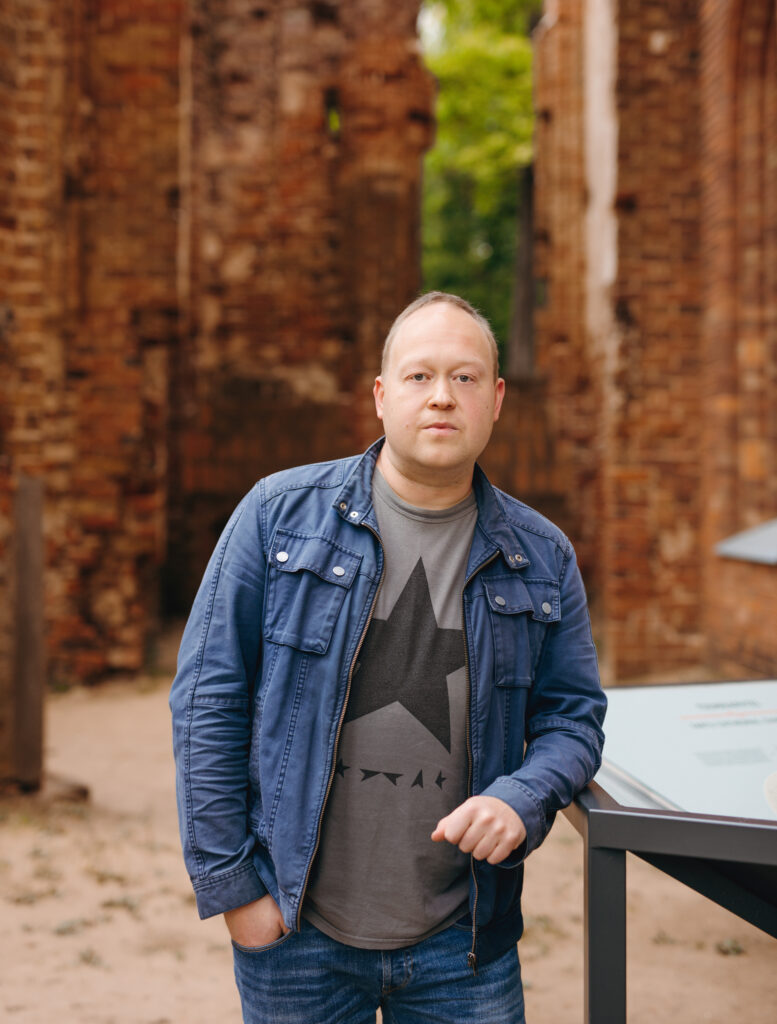
Jaak Tomberg (b. 1980) is an associate professor of contemporary literature at the University of Tartu whose main areas of research are philosophy of literature, poetics, science fiction, and literary utopias. He has a bachelor’s degree in Estonian literature (2002), and a master’s degree (2004) and PhD (2009) in comparative literature. He has published three monographs: Extrapolative Writing (2004) focuses on the poetics of cyberpunk, The Reconciliatory Purpose of Literature (2009) on the function of fiction in the field of tension between possibility and necessity, and How to Fulfil a Wish (2023) on the fate and status of realism, science fiction, and the utopian imagination in a technologically saturated, globalized cultural reality. Besides academic research, Tomberg has written a lot of award-winning literary criticism, edited the experimental avant-garde journal VIHIK, translated fiction, and written plays. In 2014, he was awarded the Science Fiction Research Association’s Pioneer Award for the best essay-length article of the year.
Main publications
Monographs
Kuidas täita soovi. Realism, teadusulme ja utoopiline kujutlusvõime. Studia litteraria Estonica 24. Tartu: Tartu University Press, 2023, 308 pp. [‘How to Fulfil a Wish. Realism, Science Fiction, and the Utopian Potential’.]
Kirjanduse lepitav otstarve. Tartu: Tartu University Press, 2011, 200 pp. [‘The Reconciliatory Purpose of Literature’. The ‘Heuremata’ series.]
Ekstrapolatiivne kirjutamine. Tulevikukirjutuse poeetikast. Studia Litteraria Estonica 7. Tartu: Tartu University Press, 2004, 108 pp. [‘Extrapolative Writing. On the Poetics of Science Fiction’, a MA thesis.]
Books, special editions of journals (in English)
Eva Näripea, Virve Sarapik, Jaak Tomberg (eds), Koht ja paik/Place and Location VI. Studies in Environmental Aesthetics and Semiotics. Tallinn-Tartu: Eesti Kirjandusmuuseumi kultuuri- ja kirjandusteooria töörühm jt, 2008, 354 pp.
Eva Näripea, Virve Sarapik, Jaak Tomberg (eds), Koht ja paik/Place and Location V. Studies in Environmental Aesthetics and Semiotics. Tallinn-Tartu: Eesti Kirjandusmuuseumi kultuuri- ja kirjandusteooria töörühm jt, 2006, 320 pp.
Articles (in English)
Morality and Amorality in Ba(udri)llard’s “Crash”: A Poetic Perspective. Science Fiction Studies, vol 47, no 1, 2020, pp 47-72.
Non-SF Cyberpunk. – Routledge Companion to Cyberpunk Culture. New York, London: Routledge, 2019, pp 81-90.
Good Old-Fashioned Future. – Kati Ilves (ed), Ascending from the Liquid Horizon. Rome: CURA.BOOKS, 2018, pp 64−69.
The Awakening of the Dystopian Hero: On the Ambiguity in the Utopian Form. – Kunstiteaduslikke Uurimusi / Studies on art and architecture, vol 26, no 1–2, pp 33−48.
The Possibility of a New Consciousness. – Katja Novitskova, Kati Ilves (eds), If Only You Could See What I’ve Seen With Your Eyes. Berlin: Sternberg Press, 2017, pp 20−27.
Author’s Response. Correspondence and Verisimilitude in (Science) Fiction. – Science Fiction Studies, no 122, 2014, pp 248-251.
On the “Double Vision” of mimetic realism and science-fictional estrangement in William Gibson’s “Bigend trilogy”. – Science Fiction Studies, no 120, 2013, pp 263-285.
Eastern-European Science-Fictional Space Through the General Representability of the Other. – Interlitteraria, vol 16, no 1, 2011, pp 269-287.
Marina Grishakova, Jaak Tomberg, Katre Pärn, On the Obligation Toward a Difficult Whole. Interview with the Distinguished Humanities Professor Brian McHale (Ohio State University). – Hortus Semioticus, no 3, 2008, pp 5-17.
City as the Site of Externalized Subjectivity. – Interlitteraria, vol 12, 2007, pp 371–378.
The cyberpunk novel: Futurist visions that tell us about the present. – Interlitteraria, vol 9, 2005, pp 238-245.
The Absolute Space: The Impact of the Virtual. – Virve Sarapik, Eva Näripea, Kadri Tüür (eds), Koht ja Paik; Place and Location, vol 4. Tallinn: The Research Group of Cultural and Literary Theory, Institute of Art History (Estonian Academy of Arts), Estonian Semiotics Association, 2004, pp 169-181.